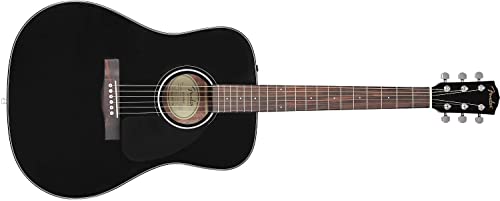If you’re thinking about learning to play the guitar but aren’t sure which you should start with first: acoustic or electric, this guide is for you. Many new guitarists struggle with deciding if one is better than the other when starting out.
Being a complete novice to the guitar can make you unsure of the differences between the two and whether one is easier or preferable to begin learning on. You want to make the right choice and give yourself the best chance of learning comfortably (and becoming good!).
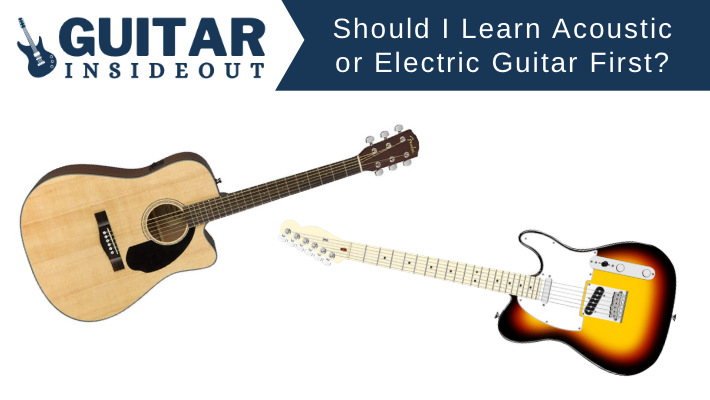
In this guide we will look at the differences that the two types of guitar have, the pro’s and con’s of learning on each and which is ultimately the best depending on what you want to achieve.
Should I Learn Acoustic Guitar or Electric Guitar First?
The simple answer is you should learn on whichever you want to. When it comes to the basics both guitars are very similar and the fundamental techniques are universal so there really isn’t enough of a difference to matter.
What I would say though is that the greatest motivator to learning to play the guitar is the music that inspires and speaks to you.
If you’re a huge fan of rock or metal and it’s that music that has made you want to play guitar then it makes sense to start with the electric. If however you aspire to be a singer songwriter and are influenced by people like Ed Sheeran, Bob Dylan or Paul Simon etc. then the acoustic is obviously where you should begin. Maybe you love classical guitar, in which case a nylon string classical guitar will be for you.
Nothing is going to make you give up learning to play faster than choosing a guitar based on what is easier or considered ‘correct’ rather than one that allows you to play the music you love.
So in terms of which is the right choice – there isn’t one. Either will be absolutely fine and thousands of people before you will have started on both and gone on to be great guitarists. The only thing that matters is you have a passion and drive for music and learning to play.
However, if you are genuinely happy with either and still not sure which would be best then keep reading as we will break down the pros and cons of both and hopefully help you make a final decision.
Pro’s of Learning Electric Guitar First
Let’s look at the positives of learning to play the electric guitar first and why it might be better suited to you.
The Strings
One major difference between the electric and acoustic guitar is the strings they use. An electric guitar’s strings are much thinner than the acoustic.
As the strings are thinner you will find it easier to hold them down when you’re first learning. You also have to go through a little pain to build calluses on your fingers when you’re starting out. This will be easier and less painful with the thinner electric strings.
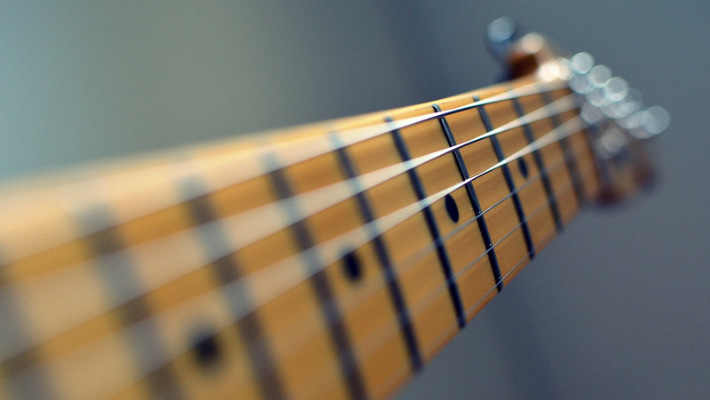
The Action
The action of a guitar is how far the strings are from the fretboard. A low action means they’re much closer to the fretboard and is often found on the guitars of those playing very fast, technical music. Having low action means you can move faster across and around the fretboard. The downside to lower action is you’re far more likely to get fret buzz.
Higher action is more difficult to play but has a better tone and sounds better when bending the strings. Often blues guitarists will have higher action for those reasons.
Electric guitars will almost always have a lower action than an acoustic. When you’re new to the guitar it can be easier to have the strings closer to the fretboard as it requires less effort to hold them down.
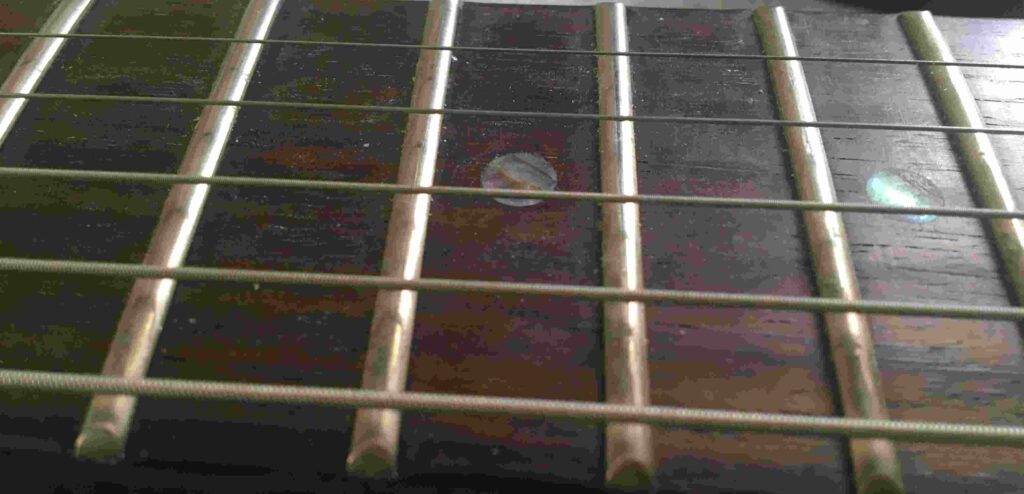
For more information see our guitar action guide.
The Neck
Guitar necks come in different sizes and shapes. Electric guitars tend to have thinner necks than acoustics which are wider and fatter.
That means getting your fingers around the neck and gripping it might be more straightforward with an electric than the acoustic.
If you’re just starting to learn the guitar then having a thinner neck that you can get your fingers round and find more comfortable could be the way to go.
Con’s of Learning Electric Guitar First
It’s not all positives for the electric though. There are some drawbacks which we’ll go through.
The Weight
As an electric guitar is a solid block of wood (assuming it isn’t chambered). That makes it heavy. An acoustic is hollow and so much, much lighter.
When you’re starting out it can be difficult to hold and get the right position with the guitar. Having a heavier electric can make that more of a struggle than the lighter acoustic.
Accessories
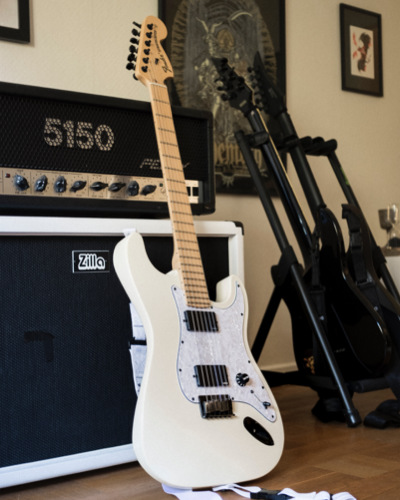
In order to play the electric guitar you really need an amplifier, cables, a strap, picks etc. You can play it unplugged but you lose any of the feel and dynamics of playing through a proper amplifier. That’s the way electric guitars were designed to be played.
An acoustic on the other hand needs nothing. If you prefer to play with a pick then that’s about all you would need, and even that’s not 100% necessary.
So the electric guitar certainly requires buying more to begin with and needing all the bits and pieces compared to the acoustic.
String Noise
When playing an electric guitar through an amplifier the pickups are sensitive to any vibration of the strings. So as a beginner you get a lot of unwanted noise until you learn to control and “mute” the strings you aren’t playing.
This is an added bit of technique you need to learn when playing the electric that you don’t with the acoustic guitar. For beginners it can be very frustrating to struggle with the basics of forming chords, holding down the strings and getting them to sound right without the extra annoyance of this unwanted noise.
Procrastination
Within the guitar community there is a phenomenon named GAS – which stands for Guitar Acquisition Syndrome. It refers to those who as they become more immersed in the world of playing the guitar can’t stop buying (or acquiring) guitars and guitar related gear.
It’s talked about like it’s an illness and addiction, and whilst it’s meant as a joke there is some truth behind it. If you become a keen guitarist there’s a good chance you will find yourself wanting to own multiple guitars, amps and pedals.
And what that leads to is a sort of paralysis when it comes to playing and learning. Instead of sitting down and practicing you end up fiddling with your different guitars, messing with your amp settings and tweaking the controls on your pedals. All time wasted when you could and should be playing!
This is far, far more common with electric guitars and guitarists. The acoustic is fairly solitary and you can’t waste much time fiddling with it. You just play.
But the electric is notorious for the hours you can procrastinate and spend doing nothing but messing around rather than something productive. So beware!
Pro’s of Learning Acoustic Guitar First
The acoustic definitely has its plus points too for learning first on. Let’s look at why you might want to start learning on the acoustic guitar.
Simplicity
As mentioned earlier the electric guitar needs a lot of extra gear to get started. The acoustic guitar is very straightforward. As long as it’s got some strings on it then you’re good to go.

You can strum or fingerpick without a plectrum, you don’t need an amp as the acoustic amplifies itself, and there’s no need for any cables to plug it in. All you have to do is sit down and start playing.
It’s also simpler to take with you and play. Gigging musicians have to travel with or transfer not only their electric guitar but heavy amplifier(s). If you’re only playing acoustic you can just put it in its case and set off.
And you’re probably familiar with people playing guitar around a campfire. That’s only really possible with an acoustic guitar as again, the electric needs an amplifier and a power source.
If you just want to be able to ‘pick up and play’ then the acoustic guitar may be the choice for you.
Beginner Songs
Most beginner songs are well suited to the acoustic guitar as they just involve strumming 2 or 3 chords. You can strum and sing along with yourself or strum with friends.
The electric is similar but can be more “riff” based which might be harder to learn at first. And whilst riffs might sound good they are a limited to playing on your own until you’ve mastered a full song.
With the acoustic you can very quickly be playing basic songs that everyone knows and feel like a proper guitarist.
Con’s of Learning Acoustic Guitar First
There are of course some negatives to the acoustic when first learning to play the guitar.
Strings
As mentioned earlier, acoustic guitar strings are much thicker. When you’re new to playing the guitar holding down those thick strings can be hard and painful.
So the thicker, heavy gauge strings on acoustic guitars may be more difficult than the electric when you’re a beginner.
Size
Not all acoustic guitars are big – famously Ed Sheeran uses a Little Martin which is a much smaller acoustic – but the majority are larger and can be slightly awkward to play (at first at least).

The electric guitar may be heavier but it’s a smaller and easier shape to sit with. Most find it simpler to hold and and get comfortable with because of the ergonomics.
So you may find starting with the larger acoustic a bit cumbersome and clumsy.
Is an Acoustic Guitar Cheaper than an Electric?
One aspect we haven’t talked about is budget. A guitar isn’t a small purchase. Top quality instruments can be very expensive. Even the basic models aren’t cheap.
So if you’re on a tight budget or are worried you might find the guitar isn’t for you and give up it’s understandable you don’t want to spend too much.
In the past acoustic guitars tended to be the more affordable of the two, and cheaper electrics were dreadful. However, you can now find really good quality entry level electrics that are far better than they used to be. Starter packs are a good place to begin as you get everything you need – guitar, amp, strap, picks etc. – all in one go.
So price and budget will still definitely be a consideration, and the need for more gear that comes with the electric guitar is unavoidable. But the quality of the instruments shouldn’t worry you.
Will an Acoustic Guitar be Quieter than an Electric
The volume is another factor that can sometimes be overlooked when considering the differences between the two types of guitar.
Most would automatically assume an electric guitar would be much louder than an acoustic. What springs to mind first when you think of an electric guitar? Rock music maybe? Jimi Hendrix? Guitar solos? All have one thing in common – they’re loud!
Whereas when you think of an acoustic guitar you might think of softly strummed chords, gentle fingerpicking or a sweet song being sung over the top of quiet playing.
Those aren’t necessarily wrong but they don’t tell the whole picture.
Firstly, an acoustic guitar can be surprisingly loud. If you strum it with a fairly thick plectrum and even a little force it will make a sound loud enough that everyone in your house/apartment will probably hear. It isn’t the whisper quiet, dainty little instrument many would think it is.
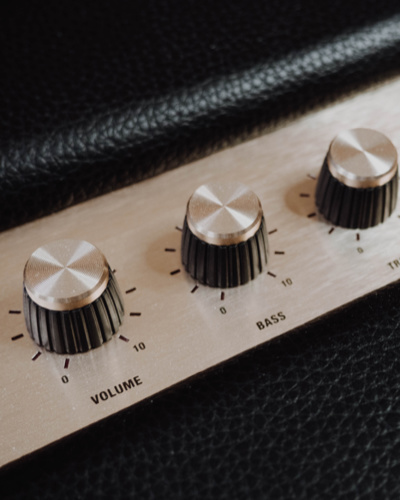
Secondly, an electric guitar doesn’t have to be loud. Sure, you can turn the amplifier up really loud and it’ll annoy the neighbors. But you can also turn it right down so that it’s very quiet. Quiet enough so that anyone else in your house/apartment won’t hear it.
Many amplifiers come in a variety of watts (generally the lower the watts the quieter the amplifier) and have fantastic volume controls meaning you can play at volumes that the neighbors won’t be annoyed by and your family can still hear the TV.
They also have headphone sockets meaning you can play through headphones that only you will hear. Perfect for late night jamming!
So if you were worried that an electric might be too loud and leaning towards the acoustic being the better choice for that reason it isn’t necessarily the case.
Is it Easier to Learn Electric Guitar than Acoustic?
No. The common misconception is that the electric guitar is the easier option but that isn’t the case.
At the beginning both will be hard. They will require dedication and the will to learn. Even if the electric guitar was easier to learn than the acoustic during the early stages both will feel so alien and difficult that you won’t really notice it.
Searching for a shortcut – in this case finding the easier option – is a fools errand.
Just look through the positives and negatives listed above. You’ll see how each of the two different types of guitar have some things that will make them easier and some that will make them harder.
In the end it evens out. You should choose the guitar you want to learn, not the one you think will be simpler.
Can I learn Electric Guitar Without Learning Acoustic?
Yes, absolutely. Many people are only interested in playing electric guitar and so have learnt just that. They ignore the acoustic entirely and that doesn’t hold them back at all.
Now, once you start playing guitar what often happens is you begin to love the instrument as a whole. Your taste in music may change or expand and so whilst the idea of playing the acoustic may not appeal now, in the future there’s a good chance you will feel different.
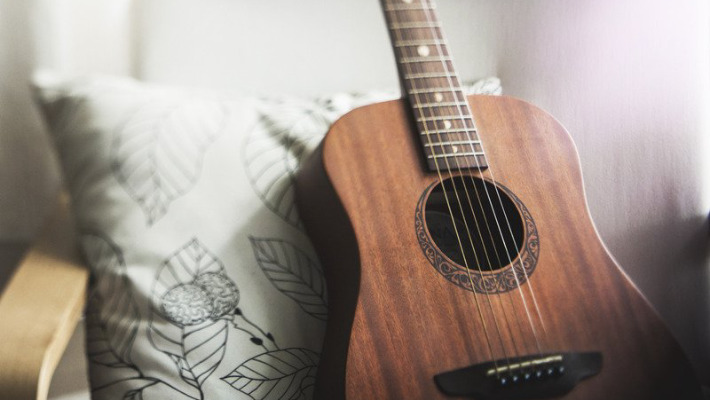
Thankfully you can pick up either guitar at any point. So even if you’ve no interest in the acoustic right now, if in a year, 2 years or even 10 years time you find yourself loving it’s subtler sound then there is nothing stopping you playing one.
Choosing your First Guitar
If you’ve decided on the type of guitar you want or this article has helped you get closer to knowing you may now be wondering which to buy. How do you tell and know which guitars are good and which aren’t? Or which would be suited for the style of music you want to play.
These are a few recommendations that would make great choices for your first electric or acoustic guitar.
Electric Guitars for Beginners
We will start with some great guitars for beginners that would be the best way to start your guitar journey and will serve you well for years to come.
Fender Squier Classic Vibe Stratocaster/Telecaster
Brand: Fender
Body: Pine
Neck: Maple
Fretboard: Maple
Pro’s:
- Amazing quality for the price
- Good for a wide range of music styles
- Classic looks
- Well known brand
Squier is Fenders more affordable range of guitars that are priced lower to compete with the other entry level guitars.
The Classic Vibe range has become the standout from the Squier series and is regarded as one of if not the best “beginner” guitars available. Many have commented on how they’re actually just a really good guitar full-stop and could easily be used regularly by gigging guitarists.
The Stratocaster and Telecaster are two of the most famous guitar shapes and are both perfectly suited for pop, country, blues and rock music.
Fender Bullet Mustang
Brand: Fender
Body: Poplar
Neck: Maple
Fretboard: Laurel
Pro’s:
- Amazing quality for the price
- Humbucker pickups for great tone
- Good neck for small hands/beginners
- Well known brand
I think the Bullet Mustang is somewhat underrated. It’s amazingly affordable and you get such a great guitar.
It’s a short scale guitar, which means it’s got a shorter and smaller neck (the frees are closer together) that makes it easier for beginners and those with smaller hands.
It’s widely noted for being incredible value for money: you’re getting a lot of guitar for such an affordable price. The hardware – that’s is the pickups, bridge, tuners etc – are all very good quality.
And it looks great! That imperial blue is lovely.
Its marketed as a beginner, entry level guitar but is actually far better than that. If you start with the Bullet Mustang and carry on playing you won’t need to upgrade guitars for a long time.
Ibanez GIO’s
Brand: Ibanez
Body: Poplar
Neck: Maple
Fretboard: Rosewood
Pro’s:
- Great build quality
- Very well suited for metal
- Comfortable neck
- Looks great!
If you are a bit metalhead and are inspired by metal, metalcore or any of the metal sub-genres then the Ibanez GIO series is going to a great choice. It’ll definitely be more suited to you and the style of music you want to play than the 2 Fenders mentioned above.
Ibanez are less well known than the two big boys, Fender and Gibson, but are a huge name in the guitar world and have been making quality instruments for decades. They’re more popular amongst the heavy styles of music and make guitars well suited for playing those genres.
The GIO range is the Ibanez entry level guitars but they’re a really solid choice and use some really good hardware as well as being built to last.
If you’re a metal fan then an Ibanez won’t let you down.
Epiphone Les Paul
Brand: Epiphone
Body: Alder
Neck: Maple
Fretboard: Rosewood
Pro’s:
- Great build quality
- Great for rock music
- Won’t need upgrading
The Les Paul is one of the most famous guitars, and rightly so. Unfortunately an American made Gibson Les Paul will set you back well into 4 figures. Which is a lot of money.
Thankfully Gibson own Epiphone, a subsidiary that makes their more budget friendly models (as well as some exclusive Epiphone guitars too). So you can get an Epiphone Les Paul that both looks and plays the part without breaking the bank.
And an Epiphone Les Paul is a great first guitar. It looks amazing, is really well made and sounds brilliant for rock and blues.
Acoustic Guitars for Beginners
If it’s the acoustic guitar you want to start with then these are some of the best out there to begin your journey with.
Seagull S6
Brand: Seagull
Body: Cherry
Neck: Maple
Fretboard: Rosewood
Pro’s:
- Amazing quality for the price
- Sounds wonderful
- Lovely looking and feeling
Slightly more expensive than most beginner acoustic guitars the Seagull S6 is a really quality instrument. The extra money is definitely worth it as you get such a wonderful guitar.
It may seem like a big investment but if there’s even the smallest chance you’re going to stick with it then you’ll be rewarded with a guitar that should last you for a long time. Plus it’ll hold its value if you decide to sell it on.
It sounds absolutely phenomenal with a real warmth and depth when you play. The only consideration is the Seagulls neck is fractionally wider than many other acoustics. If you’re worried about small hands you may want to keep that in mind.
They also use sustainable wood from Canada so if you’re environmentally conscious this is very much the guitar for you!
Yamaha FG-800
Brand: Yamaha
Body: Mahogany
Neck: Maple
Fretboard: Rosewood
Pro’s:
- Very strong build quality
- Great for all types of playing
- Popular for decades
Yamaha may be more well known for their keyboards (or motorbikes) but they actually make some really brilliant guitars. The Yamaha Pacifica could easily have made the best beginner electric guitars listed above. In this case though the FG-800 is definitely one of the best and most affordable acoustic guitars you can buy.
It may not be quite as good as the Seagull S6 but for those unsure of their commitment to learning to play and want to start with something more affordable then the FG-800 is ideal.
With a lovely tone and playability it’s a well balanced and strong guitar. A big seller for a reason, many guitarists will cite the FG-800 as their first guitar.
Fender CD-60
Brand: Fender
Body: Mahogany
Neck: Mahogany
Fretboard: Walnut
Pro’s:
- Bright and dynamic sound
- Comfortable neck and fretboard
- Fender, so you know it’s good
You can’t really go wrong with a Fender and the CD-60 is another winner.
With a classic body shape and tone along with its comfortable fingerboard the CD-60 makes for a great entry point into the world of acoustic guitars.
Be aware of body size though: the CD-60 is a dread sight which is one of the larger sizes. If you’re small you may find it a bit too big for you.
Beginner Amplifiers
If you’re getting an electric guitar then you’re going to need an amplifier. These are a few of the best beginner amps that are easy to use but still sound great.
BOSS Katana
Type: Solid State
Configuration: Combo
Power: 50W/100W
Dimensions: 18″ x 10″ x 16″
Pro’s:
- Really good range of tones
- Very quiet (and loud if need be!)
- Great software
- Good size and portable
The BOSS Katana is probably the best bang for buck amplifier you can buy right now. And I don’t mean best of the beginner amps, I mean of all amplifiers for all skill levels. It’s really good.
You get a huge range of different tones and models of amps, lots of builds in effects to try out and you can play at whisper quiet volumes all the way up to really loud.
It’s almost certainly the best amp for those just starting to play electric guitar.
Yamaha THR
Type: Solid State
Configuration: Combo
Power: 20W
Dimensions: 14.5″ x 5.5″ x 7.2″
Pro’s:
- Very convenient size/portable
- Useful software to tweak your sound
- High quality amp models
- Wireless and Bluetooth
Hot on the heels of the BOSS Katana is the Yamaha THR. A true desktop amp in that it genuinely sits on your desktop. But don’t let it’s size fool you.
The THR packs a lot of punch! It has a wide range of tones combined from some of the previous THR models and with the built in Bluetooth and wireless options you can play easily anywhere.
The Katana has a few more options (what with the built in effects) but there’s no doubting the Yamaha THR is perfect if you don’t have much space and still want a great sounding amp.
Fender Mustang LT-25
Type: Solid State
Configuration: Combo
Power: 20W
Dimensions: 8.25″ x 14.5″ x 12.7″
Pro’s:
- Easy to use
- Lots of presets and tones
- Good size
- Well known brand
Fender are arguably the most well known maker of amplifiers and so it’s no surprise they would have a really top amp for beginners.
Slightly confusingly it shares its name with one of the Fender guitars – the Mustang mentioned earlier. So if you buy the bullet Mustang and Mustang LT-25 you can play a mustang through a mustang!
The LT-25 is designed specifically with beginners in mind and is made to be extremely easy to use. It has 30 presets that give you a very wide range of sounds and types of guitar tones. Combined with the onboard effects and it’s practical size make it perfect for those new to the guitar.
It’s a great first amp, both in terms of sound and it’s size and will be a fantastic starting point for getting familiar with how the guitar sounds.
Where to Begin Learning Guitar
You’ve now got your guitar but where and how do you start learning to play it?
You’re in luck because there has never been a better time to learn to play the guitar (or any instrument). The internet is packed full of amazing resources, courses and videos that make teaching yourself guitar so much simpler than it ever was.
A good starting point is JustinGuitar who offers virtually all his lessons for free. It’s a fantastic resource and has helped thousands of those new to the guitar progress and become proficient in playing.
Alternatively GuitarTricks is a well respected and popular choice. It does cost but you get a comprehensive and thorough course that has also been used by thousands to learn the guitar.
Aside from that there are many other courses out there as well as countless YouTube videos if you’re keen on reaching yourself. And actual teachers are of course available!
Conclusion
Choosing a guitar can be tricky, especially if you’re new to it and know very little about the instrument.
Regardless of which guitar you ultimately get learning to play it will be challenging. That’s why the motivation and desire to play should be the biggest factor in deciding on which guitar to begin with.
If it makes you pick it up and play it – that’s the right guitar.






